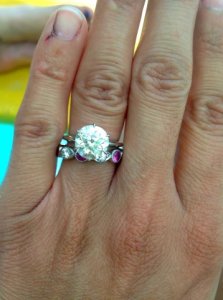InnaR
Shiny_Rock
- Joined
- May 5, 2009
- Messages
- 328
Circe|1338587424|3207506 said:Oh, Mara - that is G.O.R.G.E.O.U.S!
Mara|1338584383|3207477 said:This also is so curious to me. I know that more and more people are recutting old large stones because they can get more for them as a MRB than they could as a wonky OEC.
I asked Adam about the origin of this stone, he didn't know but he did feel quite confident it was a real 'old' stone. I had heard that some sellers feel as though there is are sometimes purported 'old stones' being sold that are actually newly cut...though don't know why anyone would cut and try to pass off something like an OMC or OEC as old if it wasn't because again, you could get more $$ cutting it as a MRB for the general market.
It does make me wonder though what the history of this stone is. I always have been fascinated by this, in fact I'd mentioned to someone years ago after joining PS that it'd be so cool if there was a historical DB on diamonds where people could register saying they'd owned them etc, it would take a while but eventually there'd be a ton of historical data on stones! Not just diamonds, even gemstones etc.
Oh and on this particular stone, it is intriguing. It's a little wonky/out of round, but has the tiny tiny culet, the bit of tranny patterning but still a strong flower pattern under the table in certain lightings. But cut very symmetrically even though the stone itself is not symmetrically round but is not quite cushion etither. I would say that means it's OLD older, but the symmetry of it tells me that it can't be THAT old or else it'd be way more wonky. Super interesting to ponder.
On this topic - might I recommend Al Gilbertson's American Cut? I feel like a broken record because I talk about it so much, but it's a fascinating history of diamond cutting and styles. One of the things he points out is that (as he puts it) "so-called" Old European Cuts were frequently nothing of the sort, and that Americans were both prolific cutters, and interested in building a better mousetrap - er, diamond - from the start, which is what led to "superior" cuts being termed "American cut" long before they were called ideal.
One of the other things he points out is that there's no clear timeline. The book helped me to date my stone a little when I read about how transitionals can be of two sorts -"modern" pavilion, "old" crown," old" pavilion, "modern" crown, - but one of the things that he emphasized most was that there was a lot of fluidity, because cutters tended to adapt the cut to the shape of the rough more back in the day, and because old, talented cutters were working to create innovative cuts alongside young bucks who were still learning the trade at the same time that less creative older cutters were grudgingly adapting to the style set by science-hungry young dealers. So it's not as straightforward an equation as More Wonky = Older. Your stone could very well be a very old piece that was just cut by a master!
Mara|1338606902|3207646 said:That is one of my stackers...got them in NYC. Love them, so versatile!
Laila I still have my e-ring setting, JE is setting a few more melee into it to make it a full eternity band. And I still have my original w-ring which I wear usually.
Long term... I have a rose gold shank w/white basket solitaire in mind, super simple...I have been craving simple after all the years with my pave set, but just gotta figure out all the 'details'..!
